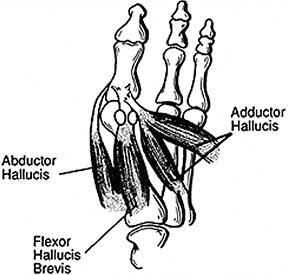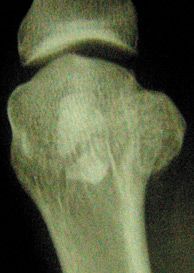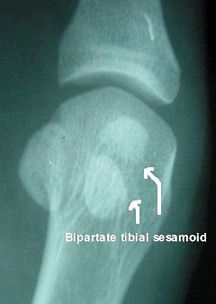Recent laws in New Jersey and California represent a disturbing trend that will negatively impact a practice’s ability to collect monies from patients, as well as expose them to significant penalties if the practice does not follow the mandatory guidelines to a T. Please be aware that a similar law may be coming to your state. The time to act is before the law is passed.
The Sesamoids Can Be a Pain
The first metatarsophalangeal joint includes four bones. The most readily apparent portion of the joint is the articulation between the concave-shaped base of the proximal phalanx and the convex, rounded head of the first metatarsal. The plantar surface includes the two sesamoid bones (fibular or lateral and tibial or medial) and the joint capsule. The joint capsule is reinforced on its plantar aspect by both a fibrocartilagenous plate and the plantar accessory ligament. The flexor hallucis longus and flexor hallucis brevis attach on the plantar aspect, along with the abductor hallucis muscle and the adductor hallucis muscle. The hallux MTP sesamoids are embedded in the tendons of flexor hallucis brevis.
Acting as a pulley for tendons, the sesamoids help the big toe move normally and provide leverage when the big toe "pushes off" during walking and running. The sesamoids also serve as a weight-bearing surface for the first metatarsal bone, absorbing the weight placed on the ball of the foot when walking, running, and jumping; or as a shock absorber for those 4" heels. They are subjected to the stresses of muscle contraction and MTP joint movement, and also to ground reaction force.
Pain involving the great-toe sesamoids is not common in the general population; however, it occurs more frequently in runners and other athletes whose sports require sprinting. There is also the confounding factor of whether or not there is a fracture as multipartite sesamoid, which can occur up to 13 percent of the time. Only 25 percent of the time does this occur on both sides.
A comparison X-ray can sometimes be helpful in determining if a fracture is present. If the bipartite appearance is present bilaterally, there is a greater chance that the sesamoid is truly bipartite and not fractured. Clues of fracture include irregular and jagged appearance of the separated fragments.

Types of Sesamoid Injuries
Turf toe: This is an injury of the soft tissue surrounding the big-toe joint. It usually occurs when the joint is extended beyond its normal range. Turf toe causes immediate, sharp pain and swelling. It usually affects the entire big-toe joint and limits the motion of the toe. Turf toe may result in an injury to the soft tissue attached to the sesamoid or a fracture of the sesamoid. Sometimes a "pop" is felt at the moment of injury. This is not an uncommon injury for football players.
Fracture: A fracture in a sesamoid bone can be either acute or chronic. An acute fracture is caused by trauma – a direct blow or impact to the bone. An acute sesamoid fracture produces immediate pain and swelling at the site of the break, but usually does not affect the entire big-toe joint. A chronic fracture is a stress fracture (a hairline break usually caused by repetitive stress or overuse). A chronic sesamoid fracture produces long-standing pain in the ball of the foot beneath the big-toe joint. The pain, which tends to come and go, generally is aggravated with activity and relieved with rest. Runners and basketball players frequently incur such injuries.

Sesamoiditis: This is an overuse injury involving chronic inflammation of the sesamoid bones and the tendons involved with those bones. Sesamoiditis is caused by increased pressure to the sesamoids. Often, sesamoiditis is associated with a dull, long-standing pain beneath the big-toe joint. The pain comes and goes, usually occurring with certain shoes or certain activities. Wearing high-heeled shoes can cause this problem.
Diagnostic Considerations
Others problems can complicate proper diagnosis. Osteoarthritis involving the sesamoid-MT joint may be a significant cause of pain in an osteoarthritic 1st MTP joint. Other causes can be overload, which might be a separate syndrome, associated with a plantarflexed first ray, without a stress fracture. Of course, diabetics may have a neuropathic ulceration that can involve one or both sesamoids.
Patients usually complain of pain under the 1st MTP joint and can often localize it, usually to the tibial sesamoid, with a finger. However, some clinicians may attach a vague label, such as "bunion," "arthritis" or "metatarsalgia" because they may not aware of the entity of sesamoid pain.
There is often a history of dorsiflexion or local impact trauma, or a change in activity leading to greater forefoot loading. However, some patients have a spontaneous onset of pain. It is also important to ask about systemic arthropathy and neurological disease including peripheral neuropathy.
Examination may show a plantarflexed first ray, with or without significant swelling. Sesamoid problems may be more common in patients with hallux valgus. There may be evidence of degenerative change throughout the MTP joint (hallux rigidus). A callus is often present under the MT head. There is usually point tenderness over the affected sesamoid, which may be exacerbated by compression or friction against the metatarsal head.
One could make the diagnosis with examination and correlating history; however, imaging with plain films is important to rule out fracture and the treatment will be different if there is an occult fracture. Standing AP and lateral forefoot films will demonstrate bipartite sesamoids and OA, but a better view is usually obtained with an axial skyline view of the sesamoids with the MTPJ in dorsiflexion.
An isotope bone scan will usually show a stress fracture and may be more accurate than an MR, although there is no real comparative data. MR will show articular problems in the MTP joint and any soft-tissue element to the problem, but this is often not relevant.
Treating Sesamoid Injuries

Acute care should include PRICE: Protection, Rest, Ice, Compression and Elevation. Restricting activity and offloading the first MTP joint, which usually involves an insole with a cut-out or pad or a modified rocker shoe, will help most patients. Of course, explanation and simple advice about shoes and analgesia should also be given.
If there is an occult fracture, more aggressive treatment will be required, including a period of immobility accomplished by placing the foot in a special boot to take all the weight off the forefoot. Some patients will need to be on crutches. Any exercise program should be delayed during the healing process. Anti-inflammatory meds may also be needed to reduce the inflammation.
Physical therapy can be used to bring increased circulation to the area and limit inflammation and pain over the long term. Functional orthotics with special accommodation to offload the sesamoids (the same as patients with a simple stress fracture) can be used once the patient is sufficiently improved to be out of the boot. In some cases, cortisone injections can be used to reduce the inflammation around the bones. Most patients will respond to conservative treatment, but will need orthotics to protect the injury from recurring.
Turf toe, sesamoiditis and hallux rigidus are a functionally interconnected set of injuries. These problems can impair the ability to run. In severe cases, a patient may consider giving up their sport permanently. Surgery may even be needed if the patient does not respond to conservative treatment.


